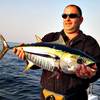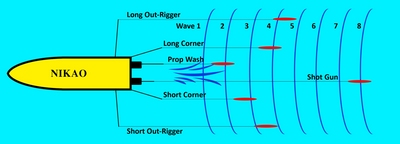It is a common belief that the fish are scared of your boat, whilst the fact is that they are actually attracted to it. Armed with this knowledge and the correct dynamics of setting up your lures; and the knowledge of how these lures perform, your can turn your small ski-boat into a mobile FAD (Fish Attracting Device) and convert your litres of fuel into kilograms of fish. This is already common practice on the large sport fishers, and with a little bit of thought you can do the same on your smaller boat using similar dynamics on a smaller scale.
The fact is that game fish are attracted to the prop wash and wake created by your boat when it is underway, and the fish actually come up to investigate this and then stumble across your lures grouped like a school of fish which they would never have seen from as far away as they can see your prop wash. Game fish are also used to chasing schools of fish as opposed to a group of one or two fish and so you need to imitate a school of fish together with the prop wash and wake created by your boat and capitalise on the inquisitive nature of these game fish. Placing your lures in the prop wash and wake of your boat is crucial to getting them to perform at their best and to get the fish to see them. They will serve very little purpose placed far behind the boat, as you need all the commotion, noise and action to make your mobile FAD work.
So many times I see anglers out on the water with a single lure trolled miles behind the boat at a slow speed and whilst this may work if your lure happens to cross the path of a fish it is not going to get the fish to come to you and it takes for ever to cover the water.
The first dynamic that you need to explore is how each of the different types of lures work, what depths they work at, what speeds do they perform at, what do they imitate, and how do they behave. Then you need to match your spread to the speed you want to troll at so that they all can perform correctly.
SOFT LURES
These are the most misunderstood lures on the market and I have seen so many anglers out there who have spent a fortune on a collection of these and after trying them once or twice unsuccessfully they stay in the box never to be used again. These soft lures are designed to work on the surface and will only work if you place them in the correct position and troll them at a speed fast enough to generate a smoke trail (trail of small bubbles). These soft lures can be separated into 5 main groups.
This group of lures is designed for high speed trolling and the faster you troll them the better. These lures are all weighted in order to keep them in the water at high speed and any where from 5 knots up to 17 knots, best between 6 knots to 12 knots and for feathers even faster. These lures will perform differently depending on the sea conditions, prevailing winds and the lure type. I love fishing with feathers (My favourite is the Williamson Feathers) and have trolled them even when my boat is on the plane at around 20 knots with extreme success so do not be scared to use them at speed when travelling long distance to and from your destination, they can produce a real unexpected surprise which really helps on a quiet day. These lures have no specific shape or action and so rely on speed to get them working and when pulled at the correct speed will create a smoke trail and you really need to test them out to see how they perform close to the boat. The best position on the wave for this type of lure will be behind the wave so that they have space to ride, placed any where else these lures will jump out of the water and start to tumble. The final positioning has to be done once you are at your desired speed and then you need to maintain that speed. If you change your speed, then you must tune the position of the lures. By doing this you will get optimal performance from your lures and the best chance of catching a fish. You need to sight the lures behind the boat and watch their position regularly and if the conditions change like your wake and lines affected by wind, swell and currents which will influence the performance of your lure. The best positions for these lures are on the long & short out rigger positions and the deadly shot gun position from the diagram. These lures also perform extremely well when rigged in conjunction with a small exciter bird on the long and short out rigger positions. Tip: You can enhance these lures by adding a strip bait to them.
Cavitators, Plungers & Darters
These are the most versatile of all the soft lures and can be placed in almost any position in the spread and are designed to surf the waves of the wake created by your boat and so must be positioned on the face of the wave to allow them to surf and create an erratic broken smoke trail as they dive with each wave and then break the surface on the next wave. Cavitators will work well on the long and short corners, long and short out riggers position and on the shot gun position and they can be used with and without exciter birds. Large Cavitators can be placed in the prop wash position without birds. These lures can be trolled between 6 knots and 10 knots, and it is important to ensure that they are created their smoke trails at the speed your troll or you will render them useless. Be sure to fine tune them once at your speed so that they are in fact surfing on the face of the wake wave. It is also important that you match your lures to perform at the same speed as other lures in your spread. This will be different for each position, each kind of boat and the prevailing weather conditions. This means that you need to experiment to find out what works best with what and when. Spend some time on the water and test all your lures out and make some notes so the next time it is easy. Tip: You can enhance these lures by adding a strip bait to them.
Flat Faced Pushers, Concave Faced Pushers and Popping Lures
Daisy chains are a group of five or six small Feathers, Squids (My favourite) or Meanie heads and are designed to enhance your mobile FAD be creating a larger school effect. These work best when placed on the short corner or prop wash positions and can be used with or without hooks. With hooks they will produce small bait fish constantly, and if you want larger fish then you rig them with out hooks to avoid the smaller fish and they will really aid your FAD by causing smaller bait fish to run with your school and enhance your effect. Daisy chains can also be used in conjunction with exciter birds. There is not really enough space on a small ski-boat to place a spreader bar and if you really want to use one then the prop was position will be the best place to rig them. Spreader bars are best used for attracting sail fish to the boat and must be hook free.
Soft Plastics & Squids
Small squids and large squids trolled behind your boat from 1 knot to 17 knots and are extremely effective. They can be placed in any position of your spread. From bright colours to natural colours squids will always produce fish. There are several ways to rig them with and without weights so you can use them on the surface or deeper down. The same applies to soft plastic baits which are really so versatile. If weighted they work best in the prop wash, long and short corner positions. You need to get out there and experiment with soft plastics and squids.
HARD LURES
From shiners to spoons to hard plastics with enhanced actions and the age old wooden crank baits and jerk baits which in their modern form are now made from moulded plastic. I would have to say that my favourites are the Rapala X-Rap range which give phenomenal performance even at speeds as high as 8 knots and are ideally suited to swim in your spread with some live, dead or strip baits. The Rapala X-Raps have the splash bait collection which are designed to run just below the surface 1-2ft and the magnums which can dive down to 30 ft. These lures can be placed in any position in the spread and the deeper runners are best placed on the long and short corner position and the prop was position. When placing a deep runner in the prop was position you can rig your shot gun position with a dead or live bait or even use a large jet head and bring it in closer to run almost on top of the deep runner. This is very effective for catching Wahoo and Tuna. You can also rig heavy sinkers on the line to get these hard lures to run deeper. Hard lures are better trolled at slower speeds fro 1 knot up to 8 knots and can work well with certain soft lures at the higher speeds. At lower speeds hard lures will work well with live baits, dead baits and strip baits. Remember that your wake wave pattern will dramatically change at slower speeds and you make need to compensate for this by letting your lures run further back than at high speeds.
BAITS
There are numerous ways to rig baits for trolling and I am not going to go into detail with that for this article. Strip baits can be used on Squids, Feathers, Bullet heads, Meanie heads, Pushers, Cavitators, plungers and Darters and are best placed in the long and short out-rigger positions and on the long and short corner positions. Live baits can be trolled without any lures which are then best used with a circle hook placed in front of the bait, and can be used with skirts and so on. The best position for live baits will be on the long & short corners or in the prop wash position. Dead baits can be trolled with out lures in the same way as live baits or can be used with various weighted rigs to enhance their movements. Sardines, Mackerel, Squid, Bonito, Shad and other small fish all make excellent dead and live baits.
In conclusion; you need to try matching the food that is around and do not be mistaken by thinking that big lures equal big fish. For example in the summer of 2007/2008 there was large flying fish around and so larger lures produced, in the summer of 2008/2009 the flying fish were small and so small lures produced better. Many a fine fish has been taken on small lure



